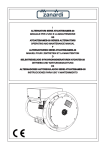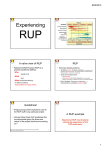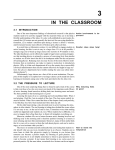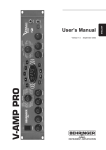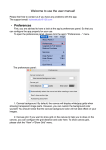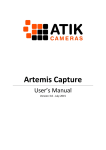Download Requirements Spec
Transcript
SOUND ODYSSEY Requirements Specification ! Table Of Contents Introduction.........................................................................................3 Purpose..................................................................................... 3 Scope........................................................................................3 Glossary................................................................................... 3 Game Overview ....................................................................................4 Game Architecture.........................................................................5 Requirements.......................................................................................7 Priorities....................................................................................7 Requirements Summary ...................................................................7 Functional Requirements.........................................................................10 Non-Functional Requirements....................................................................17 CSCI321 LM1A Jonathan Yip | Adam Dahler | Nick Herbert | Omar Mohammad-Rahim | Kieran Haavisto !1 Introduction (Purpose/Target Market, Scope) Purpose The purpose of this document is to provide a comprehensive list of prioritised requirements and give an overview of the game architectural layers to the supervisor, group members, stakeholders and marking committee. Scope This document includes details about both functional and nonfunctional requirements of high, medium and low priority at a high level. These requirements are grouped based on user interface, gameplay, storage, online, logging and miscellaneous. This document will also briefly summarise the purpose of the game through the game overview as well as outline the game architecture from front end, back end, storage and external dependencies. This document will not go into depth about design or each requirements implementation in the game. Glossary Keyboard: A keyboard used on PC for word processing, navigation and other functions that people use to operate a computer. This keyboard is can be used as an optional navigation method for in game menus. MIDI Keyboard: A digital instrument that contains piano keys used in a similar role to an analogue piano. This can be used as a game controller for the game. Asset: A resource eg. audio, graphic/image, font, level script, that included with the game. AMEB: Australian Music Examination Board. Federated, privately funded corporation which provides a program of examinations for music, speech and drama in Australia. CSCI321 LM1A Jonathan Yip | Adam Dahler | Nick Herbert | Omar Mohammad-Rahim | Kieran Haavisto !2 Game overview Sound Odyssey is a space exploration themed music education game. It is primarily an offline, single player game supported on a Microsoft Windows (7 & 8/8.1) platform. The purpose of the game is to educate people who are just starting or wanting to learn piano through a fun and engaging learning accompaniment. It will also enable experienced and intermediate pianists to practice and test their skills through challenging gameplay. The target market of this game includes people wanting to learn the piano as well as novice and beginner pianists. There are multiple game modes that enhance the learning and gameplay experience of the software. These game modes would enable the player to practice and learn the new skills they learn throughout the game as well test their competency of using these skills. These game modes test their competency in a variety of ways including their fluency, accuracy, and reaction speed when playing the notes. The testing components are based from components from AMEB exams to test the overall performance of the player’s skills. The game modes also enable the player to use their newly learnt skills to challenge themselves through levels that are highly difficult to complete and would require a high substantial amount of experience with playing the piano to do so. For users to obtain the most optimal learning and gameplay experience, a MIDI Keyboard of size 44 to 88 keys is required to play the game and get the full experience and use of the game.The MIDI Keyboard would be used as the primary game controller. This software has the possibility to enable other instruments to be used as controllers for the game. The use of other instruments would allow players to expand their skills and learn as well practice the skills they learn with other instruments. CSCI321 LM1A Jonathan Yip | Adam Dahler | Nick Herbert | Omar Mohammad-Rahim | Kieran Haavisto !3 Game Architecture INTERFACE & LEVEL CODE: User Interface, Keyboard, Level & Menu Code GAME ENGINE: Game Engine, Gameplay Controller, Event Handler, Storage Controller, File Director STORAGE: User Data, Assets, Logs EXTERNAL DEPENDENCIES: Libraries, Plugins ! Interface & Level Code This consists of the MIDI keyboard and the user interface. The game interface will display the user menus, level menus and levels, gameplay and other visual features as well as audio feedback by communicating with the Game Engine. This user interface and level code allows the user to give input and interact with game output. Game Engine The game engine is responsible for handling all elements of gameplay. They consist of modules like: physics simulation, graphics rendering, audio processing, MIDI I/O, computer keyboard I/O. The game engine also manages the handling and triggering of events. This also contains the gameplay logic as well as a means for coordinating the interacting systems. The game engine also handles the user data using storing and loading requests. CSCI321 LM1A Jonathan Yip | Adam Dahler | Nick Herbert | Omar Mohammad-Rahim | Kieran Haavisto !4 External Dependencies The external dependencies will include any libraries or plugins that are required to run this software. Storage Will be responsible for storing all data that is used within the software. For example: Game assets like models and sound packs, user data, preferences, game levels etc. Constraints The software and its requirements are limited by: Hardware - The performance of the hardware is varied however a minimum hardware requirement is needed to enable the software to run as smooth as possible to give the complete learning and gameplay experience desired by the user (See User Manual for minimum hardware requirements). The game must be played with a MIDI compatible keyboard, if a user does not own a MIDI compatible keyboard they won't be able to play the game. Software - The compatibility with multiple operating systems apart from Microsoft Windows is not possible, as well as older versions of Windows Vista and earlier. Only versions of Windows 7, 8 and 8.1 are able to consistently support the framework of the software therefore minimum software requirements are needed. CSCI321 LM1A Jonathan Yip | Adam Dahler | Nick Herbert | Omar Mohammad-Rahim | Kieran Haavisto !5 Requirements Documentation Priorities: ● ● ● ● Core - Requirements which are to be implemented before any of the other priorities. These priorities have to be met for the project to succeed. High - Requirements which are to be met after the base implementations have been met. These will most likely be delivered. Medium - Requirements which provide extra support for the project. These requirements are to be implemented after the high priorities have been met and if there is ample time available for implementation. Low - The lowest priority items which we will only attempt if there is an excess of time and all the medium priorities have been met. Requirements Summary Integration Key: Implemented / Integrated Functional but not integrated Possible extension CORE REQUIREMENTS: ID Requirement Priority F1.7 Saving and Loading progress Core F2.2 Interface Navigation with Mouse and Keyboard Core F3.1 MIDI Input Processing Core F3.3 Pausing/Suspending Gameplay Core F3.9 Level based Gameplay Core F3.10 Gameplay scoring Core F3.11 Core gameplay interactions Core HIGH REQUIREMENTS: ID Requirement Priority CSCI321 LM1A Jonathan Yip | Adam Dahler | Nick Herbert | Omar Mohammad-Rahim | Kieran Haavisto !6 F1.1 Create User Profiles High F1.2 Storing User Profiles High F1.3 Storing level statistics High F1.4 Player progress tracking High F1.5 Level Feedback High F1.8 Capability for multiple user profiles High F1.9 Autosaving player’s progress High F3.4 Menu Navigation High F3.13 Display Instructions visually/in text High F6.4 Teaching Musical Terminology High N1 Saving data quickly High N3 Loading and Initialisation Time High N7 Compatibility High N9 Ease of Use High N10 Look and Feel High MEDIUM REQUIREMENTS: ID Requirement Priority F2.1 Interface Navigation with MIDI Keyboard Medium/Low F3.2 Ship Customisation Medium F3.5 Create Custom Levels Medium F1.6 Storing Custom Levels Medium F3.6 Viewing and Playing Custom Levels Medium F3.12 Show Objective in text or visually Medium F3.14 Voice Instructions Medium/Low F3.15 Additional gameplay interactions Medium F5.1 Error Logging Medium/Low F6.4 Built-in help/glossary Medium N2 Query Processing Time Medium N4 Interface Response Time Medium CSCI321 LM1A Jonathan Yip | Adam Dahler | Nick Herbert | Omar Mohammad-Rahim | Kieran Haavisto !7 N5 Input Response Time Medium N6 Level loading Medium LOW REQUIREMENTS: ID Requirement Priority F3.7 Gameplay without MIDI Keyboard Low F3.8 Gameplay with other instruments Low F4.1 Pairing Local Profiles with Online Accounts Low F4.2 Uploading and Downloading Custom Levels via Website Low F4.3 Uploading and Downloading Custom Levels via Game Low F4.4 Online Support Low F6.1 Mobile Support Low F6.2 Achievements Low N8 Additional Compatibility Low CSCI321 LM1A Jonathan Yip | Adam Dahler | Nick Herbert | Omar Mohammad-Rahim | Kieran Haavisto !8 Functional Requirements F1 Storage ID: F1.1 Requirement: Create User Profiles Priority: High Description: Users should be able to create their own user profiles which enables the user to play the game with their created user profile and store the user data that corresponds with the user profile. ID: F1.2 Requirement: Storing user Profiles Priority: High Description: User profiles should be stored in User Data once the profile has been created as well has been played with in the game. ID: F1.3 Requirement: Storing level statistics Priority: High Description: The game should store previous attempts and statistics of each level in the player's profile. ID: F1.4 Requirement: Player progress tracking Priority: High Description: The game must be able to track the user's progress of the Campaign mode through the user’s profile data stored during run time. ID: F1.5 Requirement: Level Feedback Priority: High Description: The system should display a score summary screen after ending the level. The user must receive regular feedback to ensure they know that they are improving and becoming more experienced. ID: F1.6 Requirement: Storing custom levels Priority: Medium Description: Custom levels should be stored in a database. All data should be stored in an organised matter to allow for maximum efficiency. CSCI321 LM1A Jonathan Yip | Adam Dahler | Nick Herbert | Omar Mohammad-Rahim | Kieran Haavisto !9 ID: F1.7 Requirement: Saving and loading progress Priority: Core Description: Users are able to save and load their progress throughout the Campaign mode. ID: F1.8 Requirement: Capability for multiple user profiles Priority: High Description: The database must be able to store at least 1 user profile. User profiles will be used to identify users. A user’s data should store the usernames, game customisations, settings,high scores and statistics. ID: F1.9 Requirement: Autosaving player’s progress Priority: High Description: The game will automatically save the player’s progress after each level. F2 User Interface ID: F2.1 Requirement: Interface Navigation with MIDI Keyboard Priority: Medium/ Low Description: The user should be able to navigate through the interface of the game using the MIDI enabled keyboard. ID: F2.2 Requirement: Interface Navigation with Mouse and Priority: Core Keyboard Description: The user should be able to navigate through the interface of the game using a mouse and keyboard. F3 Gameplay ID: F3.1 Requirement: MIDI Input Processing Priority: Core Description: The system must allow the player to use a MIDI keyboard to trigger game events. ID: F3.2 Requirement: Ship Customisation Priority: Medium CSCI321 LM1A Jonathan Yip | Adam Dahler | Nick Herbert | Omar Mohammad-Rahim | Kieran Haavisto !10 Description: The user should be able to customise their ship to their desire and would be able to use the customised ship in Campaign mode. Customisation consists of both the visual representation of the ship and how it will affect the gameplay. ID: F3.3 Requirement: Pausing/Suspending gameplay Priority: Core Description: The user should be able to pause the game. ID: F3.4 Requirement: Menu Navigation Priority: Core Description: The user should be able to navigate back through the menu. ID: F3.5 Requirement: Create Custom levels Priority: Medium Description: A player should be able to create custom levels by selecting topics they want to be tested as well specify what components to produce the level. There will be parameters in which to change the visual experience of the level. ID: F3.6 Requirement: Viewing and playing custom levels Priority: Medium Description: A user should be able to view and play all local and custom levels. ID: F3.7 Requirement: Gameplay without MIDI Keyboard Priority: Low Description: A user should be able to play the game with mouse and keyboard. ID: F3.8 Requirement: Gameplay with other instruments Priority: Low Description: A user should be able to play the game with other instruments. ID: F3.9 Requirement: Level based gameplay Priority: Core Description: A user should be able to play a level in the game successfully with a MIDI Keyboard. CSCI321 LM1A Jonathan Yip | Adam Dahler | Nick Herbert | Omar Mohammad-Rahim | Kieran Haavisto !11 ID: F3.10 Requirement: Gameplay scoring Priority: Core Description: The game must assess how well the player is achieving the objective of the level. The objective of the level could be: ● Demonstrating a particular musical concept. ● Demonstrating a particular musical technique. ● Demonstrating a particular examination component (as per AMEB syllabus) ID: F3.11 Requirement: Core gameplay interactions Priority: Core Description: The game must be capable of at least the following: ● Match each note based on: ○ Velocity ○ Pitch ● Detect fluency of a series of notes ● Detect accuracy of the notes played ● Display the feedback through a visual representation when a note has been played and matched. ● Display visual representations when the player successfully completes a level. ID: F3.12 Requirement: Show Objective in text or Visually Priority: Medium Description: The game is to display the objective of a level either in text or as a visual representation. ID: F3.13 Requirement: Display Instructions visually/in text Priority: High Description: The game must be display instructions on how to play the game either in text or as a visual representation. ID: F3.14 Requirement: Voice instructions Priority: Medium/ Low Description: The game must have instructions that can be relayed to the player in audio. ID: F3.15 Requirement: Additional gameplay interactions Priority: Medium CSCI321 LM1A Jonathan Yip | Adam Dahler | Nick Herbert | Omar Mohammad-Rahim | Kieran Haavisto !12 Description: The game must be capable of: ● Detecting expressive techniques such as tremolo (quickly repeating the same note in succession) ● Analysing performance details such as tempo (speed) differences between expected notes and input F4 Online ID: F4.1 Requirement: Pairing local profiles with online accounts Priority: Low Description: Users should be able to set up an online account and pair their local profile to that account. ID: F4.2 Requirement: Uploading and Downloading custom Priority: Low levels via website Description: Users should be able to upload and download custom levels by the website. ID: F4.3 Requirement: Uploading and Downloading custom Priority: Low levels via game Description: Users should be able to upload and download custom levels in game. ID: F4.4 Requirement: Online Support Priority: Low Description: Users should be able to play online with friends as well as communicate and meet other players, share custom games online, share content and compare high scores. F5 Logging ID: F5.1 Requirement: Error Logging Priority: Medium/ Low Description: The game must store logs when an error has occurred during the run time of the game. CSCI321 LM1A Jonathan Yip | Adam Dahler | Nick Herbert | Omar Mohammad-Rahim | Kieran Haavisto !13 F6 Miscellaneous ID: F6.1 Requirement: Mobile Support Priority: Low Description: A user is able to use some features of the game through a mobile device i.e. using a mobile device as a display for the game. ID: F6.2 Requirement: Achievements Priority: Low Description: The game should have achievements for the user to aim for and promote strong playability. There will be different tiers of achievements: ● Basic: Includes completing a set of levels, completing all levels in campaign / Odyssey mode. ● Intermediate: Includes scoring higher than medium scores for all game modes and demonstrating techniques and expressional skills similar to AMEB Piano Grades 1-4. ● Advanced: Includes scoring higher than the highest scores for all game modes and demonstrating techniques and expressional skills similar to AMEB Piano Grades 5-8. ID: F6.3 Requirement: Built-in help/Glossary Priority: Medium Description: The game should possess a built-in help function or glossary that is extensible. ID: F6.4 Requirement: Teaching musical terminology Priority: High Description: The game must teach the player terminology that is used in music especially in sheet music. CSCI321 LM1A Jonathan Yip | Adam Dahler | Nick Herbert | Omar Mohammad-Rahim | Kieran Haavisto !14 Non Functional Requirements ID: N1 Requirement: Saving data quickly Priority: High Description: Data should be saved in less than 3 seconds. ID: N2 Requirement: Query processing time Priority: Medium Description: The average processing time for queries must not take over 1 second. A query could include: ● Request for user data such as score and duration of time spent during a level and statistics of that level (eg. how well a particular concept was shown). ● Request for a particular asset such as a level described by the concept that it covers. ID: N3 Requirement: Loading and initialisation time Priority: High Description: The game must load all of its assets and ready for input at the main menu for the first time after installation in at least 15 seconds with no user data. The game must load all of its assets and ready for input at any other given time after first initialisation in at least 12 seconds. ID: N4 Requirement: Interface response time Priority: Medium Description: When a menu option is pressed, the acknowledgement of the input should be shown in less than 0.1 seconds. ID: N5 Requirement: Input processing time Priority: Medium Description: The acknowledgement and processing time of the input of the MIDI Keyboard should be less than 0.25 seconds. ID: N6 Requirement: Level loading Priority: Medium Description: The system must load a level within 15 seconds. CSCI321 LM1A Jonathan Yip | Adam Dahler | Nick Herbert | Omar Mohammad-Rahim | Kieran Haavisto !15 ID: N7 Requirement: Compatibility Priority: High Description: The game must run and execute on at least Windows 7,8.1 and 10. ID: N8 Requirement: Additional Compatibility Priority: Low Description: The game must run and execute on Mac and Linux OS ID: N9 Requirement: Ease of use Priority: High Description: The interface of the game should have a high degree of usability, however this cannot be measured through quantitative analysis. Usability is often a subjective quality, which would mean that numerical data would be misleading. Qualitative analysis and interpretation of user feedback during testing is therefore required to determine if this requirement is met. ID: N10 Requirement: Look and feel Priority: High Description: Both the interface and gaming environment will be consistent across all areas of the game. The menu, controllers and game should feel familiar towards the user allowing for easy navigation and smooth gameplay. CSCI321 LM1A Jonathan Yip | Adam Dahler | Nick Herbert | Omar Mohammad-Rahim | Kieran Haavisto !16


















